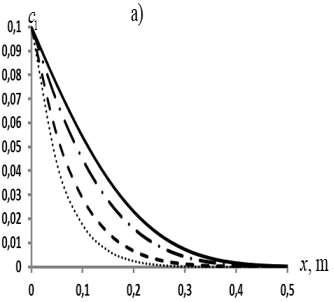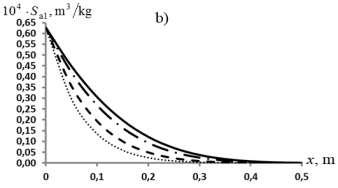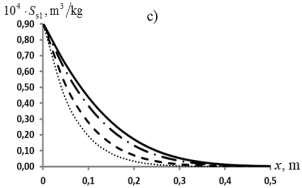Solute Transport in a Nonhomogeneous Porous Medium
Abstract The paper considers the solute transport in a heterogeneous porous medium consisting of well permeable and poorly permeable zones, taking into account nonequilibrium adsorption in the zones. In a well permeable zone, there are two areas, in each of which there is an adsorption of a substance with reversible nonequilibrium kinetics. The exchange of solute with the second zone is modeled by the source term in the form of a fractional time derivative of the concentration of the substance in the first zone. The numerical implementation of the model is carried out and the effect of mass transfer to the second zone on the characteristics of the solute transport in the first zone is estimated.
Index Terms: adsorption, adsorption kinetics, approximation, fractional derivative, porous medium.
I. INTRODUCTION
Underground aquifers and oil and gas strata, as a rule, have a heterogeneous structure at the micro and macro scales [1]. Macroscale heterogeneous formations consist of different zones with differing, sometimes very strongly, reservoir properties, i.e. porosity, permeability, etc. Areas with good porosity and permeability are good conductors for fluids and various substances suspended or dissolved in formation fluids. A typical example of heterogeneous formations are fractured porous media (FPM) [2, 3], the structure of which is represented as a system of cracks surrounding porous blocks.
Colloidal particlescan moverelativelyfasterand movelong distances in structuredporousmedia than in media with a homogeneous structure [5,6,7,8]. In such environments, when modeling the solute transport, it is usually assumed that the main paths of movement of a fluid and, along with it, suspended solids or dissolved substances in it are fractures. Porous blocks in simplified models are considered as impermeable for fluid, but particles or solute can diffuse into them. Thus, two zones are formed in the medium, one with a mobile fluid (cracks), and the other with a stationary one (porous blocks). Mass transfer processes take place between the zones.
The advance spread of substances in a porous medium can be result of many factors. Therefore, there are certain difficulties in mathematical modeling of this phenomenon. Some models in this direction were presented in [9,10,11,12]. These models used the two zone approach noted above. Mass transfer between zones is modeled by a first order kinetic equation [13, 14]. A somewhat
T.O.Dzhiyanov, M.H.Turayev, G.M.Artikova, M.A.Ruziyeva Samarkand State University, Samarkand, Uzbekistan,
different approach, combining kinetic and equilibrium mass transfer between zones, was proposed in [15]. Some modification of the two-zone approach is an approach that takes into account the movement of fluid in both zones, but with different scales [9, 10].
In [20], the process of transfer of colloids was considered under the assumption that reversible retention of colloidal particles with different characteristics (parameters) occurs in both zones. Relatively speaking, in each zone there are two regions, in one of which the rate of retention of particles is higher than in the second, and the rate of release of particles is relatively low than in the second. This approach is more realistic than in [4], since irreversible retention of particles is observed only at the initial stage of the process, when a monolayer of colloidal particles is formed on the surface of the medium rock, i.e. when there is no energy barrier for retention [17,18,19]. Thus, the irreversible retention of particles has a time limit, beyond which it becomes reversible. In [4], irreversible retention is used for the entire duration of the process, i.e. for the entire time range. In this regard, the use of double reversible retention kinetics is preferred. In this case, it becomes possible to consider the irreversible kinetics of retention as the limiting case of reversible kinetics.
In [15], the solute transport in a medium with double porosity is considered, taking into account the reversible and irreversible deposition of matter in both zones and the first order equilibrium exchange between the zones. In each zone, i.e. in fractures and porous blocks, there is a reversible and irreversible sedimentation (deposition) of a substance with different characteristics, described by linear equations. An analytical solution to the problem was obtained, which was used to describe the results of earlier experiments [16].
In this work, in contrast to [15], a new model is proposed, where the presence of the second zone of an inhomogeneous medium is taken into account in the form of a sink (source) term in the transport equation written for the first zone. The stock term is presented as a fractional time derivative of the concentration of the substance in the first zone with a certain coefficient. This model is implemented numerically.The solution is compared with the solution [15] in the first zone. It is shown that by appropriate choice of model parameters the solution can be approximated to the solution [15].
II. MATHEMATICAL MODEL
A heterogeneous porous medium is considered, consisting of well permeable and relatively poorly permeable zones, the diagram of which is shown in Fig. 1. The parameters in the first zone are indicated by the index 1. There are two sections in zone 1, in each of which the precipitation of a substance with reversible nonequilibrium linear kinetics occurs. It is believed that such processes also occur in the second zone, but we will not write equations and conditions for it. Substance exchange occurs with the second zone, which will be modeled by the fractional time derivative of the substance concentration in the first zone [20]. Consequently, in contrast to [15], the concentration field in the second zone is not considered.
The second zone
Fig. 1. Scheme of material transfer in a two zone medium
The equations of solute transport in the one dimensional case are written in the form
is the order of the derivative.
where ��2 is the coefficient due to the solute transport into the second medium,
The sedimentation of matter in each of the sections of the zones occurs reversibly in accordance with the kinetic equations
where ��
coefficients of deposition of matter from the fluid phase to the solid phase,
1;
the coefficients of separation of the substance from the solid phase and the transition to the fluid, �� 1
Let a fluid with a constant concentration of a substance be pumped into a medium initially saturated with a pure (without substance) fluid from the initial moment of time ��0. Let us consider such periods of time where the concentration field does not reach the right boundary of the medium
. Under these assumptions, the initial and boundary conditions for the problem have the form
III. NUMERICAL APPROXIMATION MODEL
Problem (4) (9) is solved by the finite difference method [21]. In the considered area
introduced a grid uniform in directions
the
the
step in time
the open grid area
The following procedure for calculating the solution is established. By (13), (14) (��
(��
, are determined, then the system of linear equations (15) is solved by the Thomas’ algorithm with respect to (��1)
. Since
,��
<1, schemes (13), (14) are stable, and for (15) the stability conditions of the Thomas’ algorithm are satisfied.
IV. NUMERICAL RESULTS AND THEIR ANALYSIS
experiments were carried out according to the above algorithm. The calculations used the following values of the initial parameters:
Some typical results are shown in Fig. 2. As seen from Fig. 2, the outflow of the substance into the second zone leads to a delayed propagation of the concentration profiles of the substance in the mobile fluid. As a consequence of this phenomenon, delays are also observed in the concentrations of the adsorbed substance.



CONCLUSION
In this work, in contrast to [15] a new model is proposed, where the presence of the second zone of an inhomogeneous two zone medium is taken into account in the form of a sink (source) term in the transport equation written for the first zone. The stock term is presented as a fractional time derivative of the concentration of the substance in the first zone with a certain coefficient. Thus, this approach is mono continuous, while in [15] the bicontinuous approach was used.
The transport model is analyzed numerically. It is shown that with a decrease in the index from unity with the remaining parameters unchanged, the precipitation of matter intensifies. As a result, a lag occurs in the development of the distribution of the concentration of a substance in a mobile fluid.
REFERENCES
1. Barenblatt G.I., Entov V.M. and Ryzhik V.M. Theory of Fluid Flow Through Natural Rocks. Kluwer Academic, Dordrecht, The Netherlands. 1990.
2. Van Golf Racht T.D. Fundamentals of Fractured Reservoir Engineering. Developments in Petroleum Science, Vol. 12. Elsevier. 1982 y. 732 p.
3. Sahimi M. Flow and Transport in Porous Media and Fractured Rock. From Classical Methods to Modern Approaches. Second, Revised and Enlarged Edition. WILEY VCH VerlagGmbH&Co. KGaA. 2011.
4. Leij F.L., Bradford S.A. Colloid transport in dual permeabilitymedia // Journal of Contaminant Hydrology. 150. 2013. P. 65 76.
5. Cey E.E., Rudolph D.L. Field study of macropore flow processes using tension infiltration of a dye tracer in partially saturated soils // Hydrological Processes. 23. 2009. P. 1768 1779.
6. Jarvis N.J. A review of non equilibrium water flow and solute transport in soil macropores: principles, controlling factors and consequences for water quality // European Journal of Soil Science. 58.- 2007.- P. 523 546.
7. Pang L., McLeod M., Aislabie J., Simunek J., Close M., Hector R. Modeling transport of microbes in ten undisturbed soils under effluentirrigation // Vadose Zone Journal 7. 2008. P. 97 111.
8. Passmore J.M., Rudolph D.L., Mesquita M.M.F., Cey E.E., Emelko M.B. The utility of microspheres as surrogates for the transport of E. coli RS2gin partially saturated agricultural soil // Water Research 44. 2010. P. 1235 1245.
9. Gerke H.H., van Genuchten M.T. Macroscopic representation of structural geometry for simulating water and solute movement in dual porosity media // Advances in Water Resources. 19. 1996. P. 343 357.
10. Selim H.M., Ma L. Physical Nonequilibrium in Soils: Modeling and Applications. Ann Arbor Press, Chelsea, MI. 1998.
11. Simunek J., van Genuchten M.Th. Modeling nonequilibrium flow andtransport processes using HYDRUS //Vadose Zone Journal 7. 2008. P. 782 797.
EUROPEAN SCIENTIFIC BULLETIN
2694-9970
12. Toride N., Leij F.J., van Genuchten M.Th. The CXTFIT code for estimating transport parametersfromlaboratoryorfieldtracerexperiments.Version2.0.Res.Rep.137.U.S.Salinity Lab, Riverside, CA. 1995.
13. Coats K.H., SmithB.D. Dead end pore volume and dispersion in porous media // Soc.Pet.Eng.J. 1964. No. 4. P. 73−84.
14. Van Genuchten M.Th., Wierenga P.J. Mass Transfer Studies in Sorbing Porous media.I. Analytical Solution // Soil ScienceSocietyof AmericaJournal, 1976. Vol.40,N.4. P.473−480.
15. Leij F.J., Bradford S.A. Combined physical and chemical non equilibrium transport model: analytical solution, moments, and application to colloids //Journal of Contaminant Hydrology. 110. 2009. P. 87 99.
16. Bradford S.A., Simunek J., Bettahar M., van Genuchten M.T., Yates S.R. Modeling colloid attachment, straining, and exclusion in saturated porous media // Environmental Science & Technology. 37. 2003. P. 2242 2250.
17. Bradford S.A., Torkzaban S. Colloid transport and retention inunsaturated porous media: A review of interface , collector , and pore scale processes and models //Vadose Zone Journal. 7. 2008. P. 667 681.
18. Elimelech M. et al. Particle Deposition and Aggregation: Measurement, Modelling, and Simulation. Butterworth Heinemann. Oxford, England,1995.
19. Gitis V., Rubinstein I., Livshits M.,Ziskind M. Deep bed filtration model with multistage deposition kinetics // Chemical Engineering Journal. 163.- 2010.- P. 78-85.
20. Khuzhayorov B. Kh, Djiyanov T.O. Solute Transport with nonequilibrium adsorption in an inhomogeneous porous medium // Scientific journal «problems of computational and applied mathematics». 2017. № 3(9). P. 63 70.
21. Samarskiy A.A. The theory of difference scheme. М. The science. 1977. P. 656.
